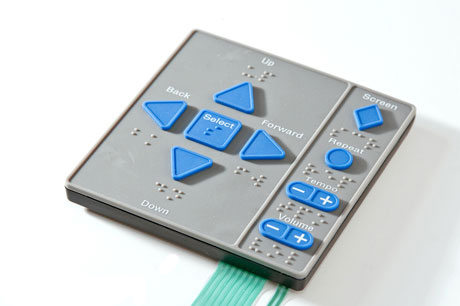Comprehending the Importance of Membrane Switches in Interface
Membrane buttons are important components in the layout of efficient interface, helping with not only capability however also improving aesthetic charm and user communication. Their special features, such as resistance to ecological factors and adjustable layouts, make them ideal for a diverse selection of applications across several sectors. As we check out the different benefits and future trends linked with Membrane innovation, it comes to be clear that these buttons are greater than simply elements; they represent a merging of development and practicality. The ramifications of this technology on individual experience deserve examining even more.
What Are Membrane Buttons?

The spacer layer, which contains adhesive residential properties, permits the separation of the circuit layer from the overlay, making certain that the switch remains in a non-activated state up until pressed. When stress is applied to the overlay, it presses the spacer layer, linking the void and finishing the circuit in the underlying layer. This layout not just lowers the physical room needed for typical mechanical switches but also enhances the durability of the tool, as Membrane buttons are normally resistant to dust, wetness, and other environmental factors.
Typically found in applications ranging from consumer electronic devices to clinical gadgets, Membrane switches are essential to contemporary technology, providing a efficient and user-friendly interface that straightens with contemporary design demands.
Advantages of Membrane Buttons
While many button innovations exist, Membrane Switches deal distinct benefits that make them particularly preferable in different applications. One of the key benefits of Membrane switches is their compact design, which enables space-saving implementations in tools where property is restricted. Their thin profile not just boosts visual appeal yet also promotes light-weight building.
An additional considerable advantage is their resistance to environmental variables. Membrane switches are typically secured versus moisture, dirt, and contaminants, making them suitable for use in requiring atmospheres, such as clinical gadgets and commercial tools. This resilience prolongs the life expectancy of the switch, lowering maintenance expenses and improving integrity.
Furthermore, Membrane buttons can be tailored to fulfill specific design needs, incorporating special graphics and shades that boost user communication. Their responsive responses alternatives can additionally be customized to give a gratifying user experience. Additionally, Membrane switches are affordable, specifically in high-volume applications, as they can be produced effectively.
Applications in Different Industries

In the consumer electronics market, Membrane buttons prevail in gadgets such as microwaves, cleaning makers, and push-button find more info controls. Their responsive feedback and aesthetic choices boost user experience while offering a smooth, modern-day appearance. Additionally, automotive manufacturers make use of Membrane switches in dashboard controls and infomercial systems, where area is limited, and customer interaction is crucial.
Moreover, the commercial sector leverages Membrane switches in control panels for machinery and devices, permitting user-friendly procedure in commonly rough settings. Their resistance to chemicals and moisture makes certain durability and reliability in these applications. On the whole, the versatility of Membrane Switches adds considerably to their widespread use, making them important in different technological domains.
Layout Considerations for Membrane Buttons

When designing Membrane buttons, a number of key considerations have to be taken into account to make sure optimal performance and customer experience. The choice of products is vital; selecting sturdy, high-quality substratums can enhance the button's click to read durability and resistance to environmental variables such as moisture and temperature level fluctuations.
Second of all, the design of the visuals overlay must focus on clarity and simplicity of use. Symbols and message must be understandable, and the design should assist in intuitive communication (membrane switches). Additionally, responsive feedback is vital; integrating a tactile dome or various other systems can improve the individual experience by providing physical confirmation of activation
An additional essential aspect is the button's electric performance. Developers need to guarantee that the conductive traces are properly made to reduce resistance and stay clear of signal interference. This includes analyzing the required actuation force and making certain compatibility with the digital elements they will user interface with.

Future Patterns in Membrane Innovation
As innovation remains to advancement, Membrane buttons are poised to advance considerably, driven by technologies in materials and producing strategies. One emerging pattern is the unification of advanced materials, such as adaptable substratums and conductive inks, which enhance durability and lower the total weight of Membrane switches. These products not just boost the tactile reaction however additionally permit the design of switches that can stand up to harsher ecological problems.
Moreover, the combination of touch-sensitive technologies is changing traditional Membrane Switches into more interactive interface. Capacitive touch sensors installed within Membrane button panels can supply a more user-friendly and responsive customer experience, straightening with the expanding need for streamlined, modern designs in consumer electronic devices.
Additionally, advancements in printing techniques, such as electronic and 3D printing, make it possible for quick prototyping and customization of Membrane switches. This flexibility enables manufacturers to respond faster to market needs and customer preferences.
Finally, sustainability is ending up being a significant emphasis, with makers checking out green products and processes. As these trends unravel, the future of Membrane modern technology promises boosted capability, visual appeal, and environmental duty, strengthening their role in advanced interface throughout different sectors.
Final Thought
Finally, Membrane Switches represent a crucial element in the design of user interfaces, incorporating performance with aesthetic flexibility. Their benefits, including longevity and resistance to environmental elements, make them ideal for diverse applications across various sectors. Additionally, thoughtful layout considerations boost individual communication and experience. As developments in innovation continue, the evolution of Membrane buttons is anticipated to additional fine-tune interface, driving innovation and boosting usability in a progressively intricate technological landscape.
Membrane switches are important parts in the design of efficient customer interfaces, facilitating not only capability yet likewise improving visual charm and user communication.Membrane Switches serve as a crucial part in numerous user interfaces, promoting a seamless interaction in between users and digital devices.While countless button technologies exist, Membrane Switches deal distinct benefits that make them particularly preferable in various applications.Additionally, Membrane switches can be customized to meet certain design demands, including special graphics and shades that enhance customer interaction.In final thought, Membrane Switches stand for a vital element in the design of user interfaces, combining functionality with visual adaptability.